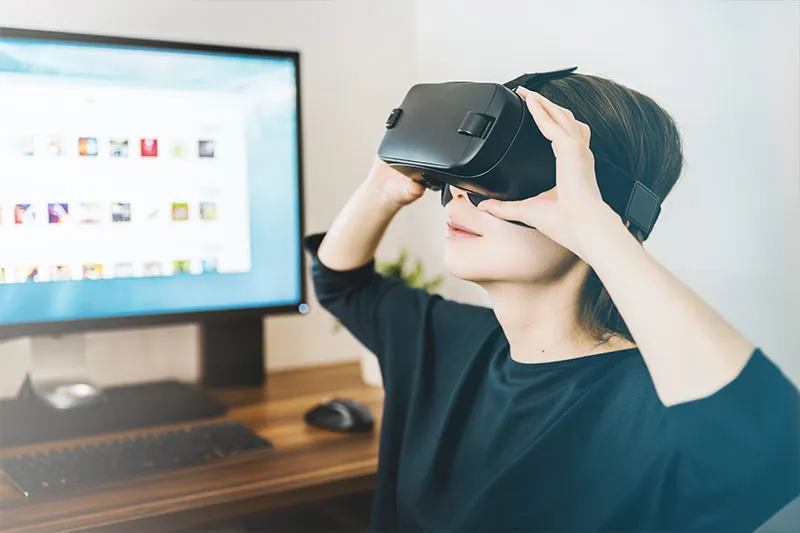Technology in the Workplace: The Role of AI, and VR

The internet and the endless onslaught of new technology in the workplace, automation, and shifting market forces is driving a revolution in job choice, job loss, and job creation in every area of business and industry like never before.
It’s changing the face of the workplace. Enterprises require new skills and talent and are increasingly harnessing technology developments to improve customer experience.
In this article, I will discuss how the latest technology in the workplace is impacting how people work and how enterprises are training customers to get the most out of their technology and people and what it takes to be a truly ‘networked enterprise’.
Table of Contents
The Modern Workplace as We Knew It
I was a paper girl back in the early 90s. It was my first ever paid job and my first step in my professional path, but oh how things have changed since then!
These days, people simply go on the internet for the latest news and the job of the local paper boy or girl has become pretty much obsolete.
It’s incredible what can happen in the space of a few years, and it’s strange to think that children entering primary school now will very likely work in job roles that currently don’t exist and will enter a workforce that will no longer resemble anything we are familiar with today.

Technology in the Workplace: What Is the Workplace of the Future?
Gone are the days of rigid corporate structures.
The ‘digital native’ generation has grown up with smartphones and social media and tend not to like unconnected, information silos – they often want regular feedback and encouragement.
This new workplace reality is having a major impact on the management styles required from leaders and the technology and tools needed to ensure a seamless customer experience.
These are the main areas where we believe technology will change the future of the workplace:
Blockchain and Recruitment
We are already seeing how technology is helping in Human Resources (HR) when it comes to searching for talent, with two great examples being LinkedIn’s impact on recruiting and Glassdoor’s on employer reputation.
The HR function was traditionally thought of as a cost center, but workplaces today are acting more like movie productions vs. traditional and typically highly administrative processes, like trawling through resumes and doing background checks.
HR is becoming more complex as a result, with groups of professionals being brought together for a project and then disbanded and reunited again for other projects – often in different combinations, with different funders.
With this new and flexible model, finding, motivating, and retaining the best employees and investing in training people is more important than ever and Blockchain technology is being seen as a strategic asset for HR departments, especially in the area of recruitment and payroll.
Right now, HR is up against it when it comes to matching up talent with where it needs to be in an organization – it’s a complex task and time is a luxury in recruitment, where speed of delivery might be the only competitive advantage.
Now that robots can identify qualified individuals and ask screening questions, HR departments can automate recruiting tasks with the help of Blockchain, to find the right talent and the roles they are best suited for, with less costs.
The globalization of businesses has lead to increasing international payroll requirements as more and more payments are being made to suppliers and business partners across borders and many companies see a very bright future for the cryptocurrency space when it comes to faster and cheaper overseas payroll processes, including Bitwage, the most popular payroll and invoicing platform built on blockchain.
In an interview with Jonathan Chester, Bitwage Founder and President, he discusses how it’s a combination of blockchain, mobile and cloud technologies that can reduce the cost of paying international employees to just 1 percent and yield same-day payouts for employees and they are not the only company that believe that the Bitcoin and cryptocurrency market is stable enough to run payroll on it – others are following suit, with Blockchain’s effect on HR set to be profound and pervasive.
AI and SaaS – Out with the Old, in with the Robots!
Artificial Intelligence (AI) is the biggest revolution since sliced bread…and the internet…
When it comes to customer experience, AI is invading the world of Software-as-a-Service (SaaS).
Your customers are using iPhones and Android phones every day, both of which have built-in AI assistants to execute some tasks without them being involved, and, every year, Apple and Google announce more features to help people get more from their smartphones without having to do more.
This technology is driving a significant change in human expectations from software and machines and AI expert, Jerry Kaplan, believes that Robots and AI are going to have a more dramatic impact on the workplace than the internet ever had – in fact, it looks like we’re going to be listening to robots more and more in future when making decisions, as analytic tools automate data for us.
This trend is changing the role of many employees with more jobs evolving focused on managing and implementing strategic initiatives, for example, SAP wanted to eliminate the need for users to manually interact with multiple work apps to get a job done and their goal was to do in the workplace what digital assistants do for consumers – chatbots and virtual assistants help us ask our phones and home devices questions and SAP CoPilot, a digital assistant by SAP was designed to help businesses with tasks like purchasing contracts and collaborating with colleagues.

Virtual Reality and Virtual Workspaces
Collaborate Wherever and However – with ever-evolving technology, work has already become something we do rather than somewhere we go now that many enterprises are fostering a company culture of flexible and remote working.
Tech companies like Microsoft and IBM were pioneers in the ´work from home` revolution, and Mark Greenaway, director of emerging business, EMEA, at Adobe, believes that remote working is one of the most revolutionary business trends in recent years and makes a case for increased productivity.
Virtual workspace collaboration technology like Mural or Skype for Business are evolving off of the back of this trend, providing the ability to interact virtually wherever people are located and communication costs have fallen because people don’t need to physically travel as much.
Teams, that are spread out across countries and continents, now collaborate in the same way they would if they were meeting up in person, sitting around the same table.
Virtual Reality (VR) is a much talked about new technology, which is still fairly new to the workplace, when I think about VR, I immediately think about the entertainment industry and video games, but enterprises are starting to leverage this technology in various other industries, for example, for training automation in the manufacturing industry.
A great example of this is how VR is transforming training programs in manufacturing plants, leveraging VR to connect field engineers with experts instead of providing service manuals and telephone support.
Real examples like this prove that what was thought to be a hype not so long ago looks set to become serious business, with Goldman Sachs predicting that VR will be an $80 million market by 2025, and all sorts of applications in the workplace are set to follow.

The Explosion of SaaS and the Challenge of Rolling out New Technology in the Workplace
People can collaborate today in ways they never could have imagined, and this is an incredible leap forward in the way we work today and the way we will work in the future. But SaaS applications can be challenging to roll out to an already-busy team because the goals tend to be something huge like, improving customer experience and employee productivity, so not surprisingly it’s implementation will involve a great deal of transitions across the company and upheaval to the business.
We’ve all been there, the thought of trying to learn a new system is inherently frustrating and answers aren’t always easy to come by, so employee productivity can take a dive.
Let’s consider this: the users of your software are the same users of iPhone and Android smartphones and despite the very cool features, they probably wish they could do just a little bit more in an even shorter amount of time.
Talking about technology in the workplace, as a marketer, I use email marketing software to send and measure the performance of email campaigns.
This is not the only software I use on a daily basis. In fact, it’s typically one of five tools I use and that number is growing!
I’m constantly needing to learn about and work with new software to be successful in my role. Also, I find that if I don’t know how to use these tools properly and get the support I need quickly, I tend to use the basic features only and file any detailed user guides I might receive via email because I just don’t have the time to read them.
I’m sure I’m not alone in thinking how much easier life would be if I could get to grips with the features of all this software a bit more quickly and if I could use any of my devices to do so. I, for one, would love to be able to use apps to focus on analytics and free up time for agile improvement of campaigns, for example, or other strategic work.
With time being a more valuable resource to software users than ever before, there are already user onboarding and staff training solutions on the market, that enable a smooth transition to user adoption.
While most modern employees and consumers have accepted new software and are using it as part of their daily lives, no-one is willing to spend time learning how to use it and given the negative impact on employee experience, enterprises cannot afford for their employees to ‘feel lost’ in software either.

What does it take to be a Networked Enterprise?
Thinking about pioneers of SaaS technology, they certainly have high hopes for creating a revolution in the ‘networked enterprise’, one that would replace corporate hierarchies and drive major growth.
However, it remains to be seen if it’s enough for enterprises to just purchase the latest technology, whether that equals true collaboration if you consider that different teams, working across different business areas are using different tools, for different reasons.
I think that after you have chosen your SaaS technology, considering how such technology in the workplace will work together across your enterprise will be critical in creating a desired employee experience that can drive real productivity and growth, as will meeting user expectations in working with all this new technology.
One thing’s for sure, as these technologies become mainstream, they’re set to play a bigger and bigger role in improving employee and customer experience, so ensuring user expectations are met and overcoming the frustration and pain of rolling out SaaS across your enterprise with a stellar training plan is bound to be at the center of every company’s change management strategy.
Do you want to test your current knowledge when it comes to digital transformation in the workplace? You can do so with our quiz! Find out how much you already know about digital transformation and see if you’re an expert already. Don’t be afraid to share your results!

